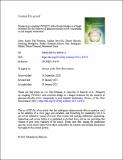Por favor, use este identificador para citar o enlazar a este item:
http://hdl.handle.net/10261/234093COMPARTIR / EXPORTAR:
 SHARE SHARE
 CORE
BASE CORE
BASE
|
|
| Visualizar otros formatos: MARC | Dublin Core | RDF | ORE | MODS | METS | DIDL | DATACITE | |

| Título: | Prospects on coupling UV/H2O2 with activated sludge or a fungal treatment for the removal of pharmaceutically active compounds in real hospital wastewater |
Autor: | Mir-Tutusaus, Josep Anton; Jaén-Gil, Adrián; Barceló, Damià CSIC ORCID; Buttiglieri, Gianluigi; González-Olmos, Rafael; Rodríguez-Mozaz, Sara; Caminal, Glòria CSIC ORCID; Sarrà, Montserrat | Palabras clave: | AOPs Fungal treatment Hospital wastewater Activated sludge UV/H2O2 Decentralized treatment |
Fecha de publicación: | 15-jun-2021 | Editor: | Elsevier | Citación: | Science of the Total Environment 773:145374 (2021) | Resumen: | Conventional active sludge (AS) process at municipal centralized wastewater treatment facilities may exhibit little pharmaceuticals (PhACs) removal efficiencies when treating hospital wastewater (HWW). Therefore, a dedicated efficient wastewater treatment at the source point is recommended. In this sense, advanced oxidation processes (AOPs) and fungal treatment (FG) have evidenced promising results in degrading PhACs. The coupling of the AOP based on UV/H2O2 treatment with biological treatment (AS or FG) treating a real non-sterile HWW, was evaluated in this work. In addition, a coagulation-flocculation pretreatment was applied to improve the efficiency of all approaches. Twenty-two PhACs were detected in raw HWW, which were effectively removed (93–95%) with the combination of any of the biological treatment followed by UV/H2O2 treatment. Similar removal results (94%) were obtained when placing UV/H2O2 treatment before FG, while a lower removal (83%) was obtained in the combination of UV/H2O2 followed by AS. However, the latest was the only treatment combination that achieved a decrease in the toxicity of water. Moreover, deconjugation of conjugated PhACs has been suggested for ofloxacin and lorazepam after AS treatment, and for ketoprofen after fungal treatment. Monitoring of carbamazepine and its transformation products along the treatment allowed to identify the same carbamazepine degradation pathway in UV/H2O2 and AS treatments, unlike fungal treatment, which followed another degradation route. | Versión del editor: | https://doi.org/10.1016/j.scitotenv.2021.145374 | URI: | http://hdl.handle.net/10261/234093 | DOI: | 10.1016/j.scitotenv.2021.145374 |
| Aparece en las colecciones: | (IDAEA) Artículos (IQAC) Artículos |
Ficheros en este ítem:
| Fichero | Descripción | Tamaño | Formato | |
|---|---|---|---|---|
| montserrat sarra 2021.pdf | Artículo principal | 1,28 MB | Adobe PDF |  Visualizar/Abrir |
CORE Recommender
SCOPUSTM
Citations
24
checked on 24-abr-2024
WEB OF SCIENCETM
Citations
21
checked on 27-feb-2024
Page view(s)
62
checked on 24-abr-2024
Download(s)
16
checked on 24-abr-2024
Google ScholarTM
Check
Altmetric
Altmetric
NOTA: Los ítems de Digital.CSIC están protegidos por copyright, con todos los derechos reservados, a menos que se indique lo contrario.
